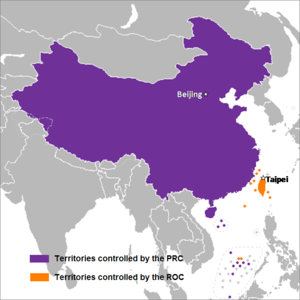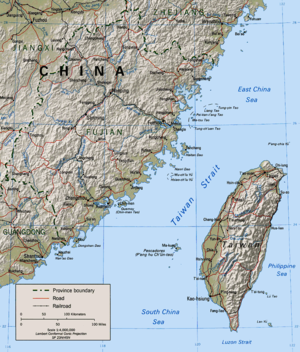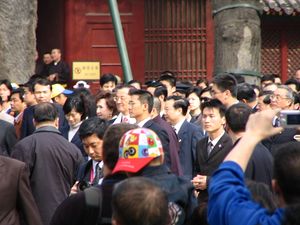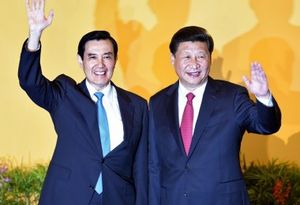العلاقات عبر مضيق تايوان
| ||||||||||||||||||||||||||||||||||||||
| ||||||||||||||||||||||||||||||||||||||

جمهورية الصين الشعبية (بالقرمزي) وتايوان (بالبرتقالي). أحجام الجزر الصغرى مكبرة لتسهيل التعرف عليها.
| العلاقات عبر المضيق | |||||||||||||||||||
|---|---|---|---|---|---|---|---|---|---|---|---|---|---|---|---|---|---|---|---|
| الصينية التقليدية | 海峽兩岸關係 | ||||||||||||||||||
| الصينية المبسطة | 海峡两岸关系 | ||||||||||||||||||
| |||||||||||||||||||
العلاقات التايوانية الصينية أو العلاقات عبر المضيق، تشير للعلاقات بين بر الصين وتايوان، والذي يفصل بينهما مضيق تايوان غرب المحيط الهادي، وخاصة العلاقات بين حكومتي الصين وتايوان.
عام 1949، أحدثت الحرب الأهلية الصينية تحول حاسم لصالح الشيوعيين، تراجعت الحكومة الصينية بقيادة كومنتانگ إلى تايپـِيْ، في تايوان، بينما أعلنت الصين الشعبية حكومتها في بكين.
منذ ذلك الحين، تميزت العلاقات الصينية التايوانية بالتواصل المحدود، التوترات، وعدم الاستقرار. في السنوات المبكرة، استمرت النزاعات السعكرية، بينما تنافست كلا الحكومتين على أن تصبح "الحكومة الشرعية" للصين". في الآونة الأخيرة، الأسئلة حول الوضع القانوني والسياسي لتايوان تركزت حول الأوجه البديلة لاعادة التوحيد السابق مع البر الرئيسي أو الاستقلال التايواني الكامل.
. . . . . . . . . . . . . . . . . . . . . . . . . . . . . . . . . . . . . . . . . . . . . . . . . . . . . . . . . . . . . . . . . . . . . . . . . . . . . . . . . . . . . . . . . . . . . . . . . . . . . . . . . . . . . . . . . . . . . . . . . . . . . . . . . . . . . . . . . . . . . . . . . . . . . . . . . . . . . . . . . . . . . . . .
التاريخ
قبل 1949
من الجمود العسكري إلى الحرب الدبلوماسية (1949–1979)

ذوبان الجليد (1979–1998)
عدم الاتصال العدائي (1998–2008)

استئناف الاتصالات رفيعة المستوى (2008–الآن)

العلاقات الرسمية الحالية
في 7 نوفمبر 2015، التقى الرئيس الصيني شي جنپنگ بالرئيس التايواني ما يينگ-جيوو في سنغافورة.
في 1 يناير 2019، أثناء كلمة ألقاها الرئيس الصيني شي جنپنگ بمناسبة مرور 40 عام على بيان سياسي لتحسين العلاقات مع تايوان، أكد شي دعوة الصين إلى إيجاد طريقة سلمية لإعادة الوحدة مع تايوان، وأضاف أن بلاده تحتفظ في الوقت ذاته بحق إستخدام القوة من أجل تحقيق هذا الهدف. وقال الرئيس الصيني في خطابه إن "الطرفين يمثلان جزءاً من العائلة الصينية"، مضيفا أن "مطالب استقلال تايوان كانت تيارا معاكسا من التاريخ لا مستقبل أمامه". وحذر الرئيس الصيني الشعبي التايوان من الاستقلال قائلا إنه "لن يجلب سوى البلاء". ويرى الرئيس الصيني أن "إعادة توحيد الصين وتايوان أمر لا مفر منه في نهاية المطاف".[1]
تفسير العلاقات
بين الحكومات
. . . . . . . . . . . . . . . . . . . . . . . . . . . . . . . . . . . . . . . . . . . . . . . . . . . . . . . . . . . . . . . . . . . . . . . . . . . . . . . . . . . . . . . . . . . . . . . . . . . . . . . . . . . . . . . . . . . . . . . . . . . . . . . . . . . . . . . . . . . . . . . . . . . . . . . . . . . . . . . . . . . . . . . .
لقاءات 2008
اللقاء الأول 2008
اللقاء الثاني 2008
اللقاء الثالث 2014
في فبراير 2014 أُعلن عن مباحثات تايوانية صينية ستعقد في نانجينگ الصينية لأربعة أيام. ومن المرجح أن يطرح المفاوضون التايوانيون مسألة تعيين ممثلين دائميين بشكل متبادل بين كلا الحكومتين.[2] لكنهم سيواجهون ضغوطا لطرح موضوع حرية الصحافة بعد أن رفضت الصين السماح لعدد من وسائل الإعلام بتغطية المباحثات. ويقول مراسلون إن من المرجح أن يضغط المفاوضون الصينيون من أجل تحقيق تعاون اقتصادي أكبر.
بين الأحزاب
غير حكومية
الدعم الجماهيري
العلاقات الغير رسمية
الروابط الثلاثة
الاستثمارات عبر المضيق
التبادل الثقافي، التعليمي، الديني والرياضي
الحراك الإنساني
أوجه أخرى
الحشد العسكري

في 29 مارس 2021، أفادت وزارة الدفاع التايوانية إن عشر طائرات عسكرية صينية بينها مقاتلات دخلت الركن الجنوبي الغربي من منطقة تحديد الدفاع الجوي لتايوان، في تصعيد جديد للتوتر عبر مضيق تايوان. وأضافت الوزارة أن القوات الجوية التايوانية نشرت صواريخ لمراقبة التوغل، دون أن تكشف عن مزيد من التفاصيل. وقالت أيضاً إن طائراتها أنذرت الطائرات الصينية عبر أجهزة اللاسلكي.[3] وفي تقريرها الدفاعي الذي ينشر مرة كل أربع سنوات واطلعت عليه وكالة رويترز للأنباء، حذرت الوزارة من أن الصين تنشر تكتيكات حربية في المنطقة الرمادية لإخضاع الجزيرة التي تطالب الصين بأحقيتها فيها، سعياً منها لإنهاك تايوان بالمناورات والنشاطات المتكررة قريباً من مجالها الجوي ومياهها. وورد في التقرير أن الصين تواصل تحديث جيشها ورفع قدراته. وتعتبر الصين جزيرة تايوان إقليماً تابعاً لها، وصعّدت نشاطها العسكري خلال الأشهر الأخيرة، سعياً منها لتأكيد سيادتها عليها والتعبير عن استيائها من الدعم الذي تقدمه واشنطن للجزيرة. وأورد التقرير أن بمقدور الصين أن تغلق بشكل جزئي موانئ تايوان الرئيسية وممراتها البحرية وتقطع عنها سبل النقل البحري، بينما يهدف نشرها للصواريخ بعيدة المدى إلى منع قوات أجنبية من تقديم دعم لتايوان. وكان رئيس الوزراء الصيني لي كه تشيانگ قد قال في وقت سابق من هذا الشهر إن الصين ستردع بقوة أي نشاء انفصالي يدعم استقلال تايوان.
في 11 أبريل 2021، أفادت مجلة أمريكية إن الصين تواصل تدريباتها العسكرية على جانبي مضيق تايوان، وتقوم مقاتلات وطائرات استطلاع تابعة للجيش الصيني باختراق مناطق تغطية الدفاعات الجوية التايوانية. وتقول مجلة ناشيونال إنترست إن الصين تستعد للحرب حول تايوان، مشيرة إلى وجود تقارير تفيد بوجود أنشطة عسكرية صينية تبدو وكأنها استعداد لعمل عسكري محتمل في مضيق تايوان. ولفتت المجلة إلى قول أحد الخبراء العسكريين من تايوان، إن التدريبات العسكرية التي تجريها الصين تحمل طابعا هجوميا. وأوضحت المجلة أن شكل التدريبات يوحي بوجود نوايا صينية لمحاصرة تايوان من 3 جهات، مشيرة إلى أن وجود أنشطة عسكرية متزايدة في اتجاه الشرق وهو ما يمكن الجيش الصيني من شن هجمات على أهداف في شرق تايوان.[4]
وتكثف الصين، التي تعتبر تايوان جزءاً من أراضيها، نشاطها العسكري حول الجزيرة خلال الأشهر الأخيرة، ردا على ما وصفته بكين بأنه "تواطؤ" بين تايبه وواشنطن، أهم داعم دولي لتايوان. وتقول وزارة الدفاع التايوانية إن الطلعات الجوية الصينية تضم قاذفات قنابل قادرة على حمل رؤوس نووية ومقاتلات حربية، مؤكدة أنها ترسل تحذيرات للطائرات الصينية وتقوم بنشر صواريخ لمراقبتها، بحسب وكالة رويترز.
وتدعي بكين السيادة الكاملة على تايوان الواقعة قبالة الساحل الجنوبي الشرقي من البر الرئيسي للصين، وأرسلت بعد أسبوع من تولي الرئيس الأمريكي جو بايدن، طائرات حربية إلى مناطق قريبة من الجزيرة، مما دفع تايوان إلى اتخاذ إجراءات دفاعية بما في ذلك مراقبة الرحلات الجوية الصينية.
وقال وزير الخارجية الصيني وانگ يي، في مارس 2021، إن مبدأ الصين الواحدة خط أحمر لا يجوز تجاوزه في مسألة تايوان، مضيفا: "لا بد من إعادة توحيد جانبي مضيق تايوان". ويحتل الجيش الصيني المرتبة الـ 3 عالميا، وبينما يأتي الجيش التايواني في المرتبة رقم 22 بين أقوى 139 جيشاً في العالم، وفقا لإحصاءات 2021، التي أوردها موقع گلوبال فاير بور الأمريكي.
في 13 أبريل 2022، أعلنت تايوان تعزيز موقعها العسكري الصغير في جزيرة دونگيين صغيرة قبالة مقاطعة فوجيان في البر الرئيسي للصين قبل نهاية 2022، مع نشر نظام دفاع آلي قصير المدى محلي الصنع. وتأتي خطة تعزيز القدرة القتالية على جزيرة دونگيين في أعقاب المخاوف التي أثيرت في فبراير عندما حلقت طائرة مدنية صغيرة من البر الرئيسي للصين بالقرب من الجزيرة، وهي جزء من أرخبيل ماتسو الذي تسيطر عليه تايوان.[5]
كانت هناك تكهنات بأن الجيش الصيني كان يستخدم هاربين واي-12 لتكثيف الضغط على تايوان من خلال اختبار إجراءات الاستجابة قبل هجوم محتمل يهدف إلى إعادة الجزيرة التي تتمتع بالحكم الذاتي إلى السيطرة على البر الرئيسي. تقع دونگيين على بعد أقل من 50 كيلومترًا شرق فوجيان وغالبًا ما يُنظر إليها على أنها إحدى الجزر الصغيرة التي قد يستولي عليها جيش التحرير الشعبي قبل شن هجوم على جزيرة تايوان نفسها.
لم تستبعد بكين استخدام القوة للسيطرة على تايوان، التي تدعي أنها جزء من أراضيها، وضغطت على رئيسة الجزيرة ذات الميول الاستقلالية تساي إنگ-ون محاولة لدفعها إلى الموافقة على محادثات التوحيد. في تقرير أرسل إلى الهيئة التشريعية الأسبوع الماضي، قالت وزارة الدفاع التايوانية إن اختبار نظام الأسلحة قد اكتمل، وطلبت من المشرعين إلغاء تجميد التمويل لنشره. وقال التقرير "من المتوقع أن ينتهي الجيش من تركيب السلاح قبل نهاية سبتمبر ومن المتوقع إجراء فحص كامل للنظام والاستيلاء عليه قبل نهاية نوفمبر"، مضيفا أن النظام يجب أن يكون جاهزا للعمل قبل نهاية العام.
خصص الجيش التايواني ميزانية قدرها 725 مليون دولار تايواني (24.8 مليون دولار أمريكي) لسبع مجموعات أنظمة، أربعة منها يجب نشرها في ووتشيو- وهي جزيرة صغيرة أخرى ضمن أرخبيل كيوموي الذي يسييطر عليها تايوان، والمعروفة أيضًا باسم كينمن، بالقرب من مقاطعة فوجيان - حوالي يونيو، وفقاً للتقرير.
تشمل الصفقة، مع معهد تشونگ شان الوطني للعلوم والتكنولوجيا، أكبر صانع أسلحة تايواني، مجموعتين من أنظمة القيادة والتحكم، بالإضافة إلى بناء الموقع وتركيب المرافق ذات الصلة. قال المطور إن النظام الآلي قصير المدى يتميز بمدفعين آليين تي-75 20 ملم مثبتين جنبًا إلى جنب، جنبًا إلى جنب مع المستشعرات المرتبطة، والطاقة، ومعدات القيادة والتحكم.
قال بعض الخبراء العسكريين إن النظام التايواني يمكن مقارنته بنظام سلاح فلاناكس الأمريكي القريب الذي يمكنه إطلاق النار ضد التهديدات القادمة - مثل القوارب الصغيرة والطوربيدات السطحية والصواريخ المضادة للسفن والطائرات ذات الأجنحة الثابتة والمروحيات - من مسافة قريبة. يمكن تركيب النظام المحلي على مركبات مدرعة وسفن بحرية وفي مواقع أرضية ثابتة. يمكن أن تدور أبراجها 360 درجة بسرعة قصوى تبلغ 60 درجة في الثانية على ارتفاع من 15 درجة إلى 85 درجة. كما يتميز النظام أيضًا بالتعرف على الصور الضوئية على متن الطائرة وتتبع الهدف والتحكم في الحرائق مما يضمن قوة نيران سريعة وشرسة وشريرة ودقيقة، وفقًا للمعهد.
تواردت أنباء لأول مرة من قبل السكان المحليين عن تحليق طائرة صينية من من دونگيين في فبراير. وأكدت وزارة الدفاع التايوانية في وقت لاحق أن الطائرة لم تحلق فوق الجزيرة مباشرة، خلافاً للتقارير الأولية. وقالت الوزارة إن الوحدات العسكرية في الجزيرة اتخذت الإجراءات المناسبة لمراقبة تحركات الطائرة ولن تستبعد احتمال استخدام جيش التحرير الشعبي للطائرة لاختبار إجراءات الاستجابة التايوانية.
. . . . . . . . . . . . . . . . . . . . . . . . . . . . . . . . . . . . . . . . . . . . . . . . . . . . . . . . . . . . . . . . . . . . . . . . . . . . . . . . . . . . . . . . . . . . . . . . . . . . . . . . . . . . . . . . . . . . . . . . . . . . . . . . . . . . . . . . . . . . . . . . . . . . . . . . . . . . . . . . . . . . . . . .
الاستقرار السياسي
انظر أيضاً
- قمعة چن-چيانگ
- اعادة توحيد الصين
- منتدى عبر المضائق التجاري الاقتصادي والثقافي
- منتدى السلام عبر المضيق
- العلاقات الخارجية لتايوان
- العلاقات الخارجية للصين
- الوضع القانوني لتايوان
- سياسة الصين الواحدة
- الوضع السياسي لتايوان
- قمة وانگ-كوو
المصادر
- ^ "الصين: نحتفظ بخيار اللجوء للقوة لمنع استقلال تايوان". بي بي سي. 2019-01-02. Retrieved 2019-01-02.
- ^ "الصين وتايوان في أول مفاوضات رسمية منذ عام 1949". بي بي سي العربية. 2014-02-11. Retrieved 2014-02-14.
- ^ "تايوان ترصد توغلاً كبيراً للقوات الجوية الصينية". جريدة الشرق الأوسط. 2021-03-29. Retrieved 2021-03-29.
- ^ "مجلة: الصين تستعد للحرب". سپوتنيك نيوز. 2021-04-11. Retrieved 2021-04-11.
- ^ "Taiwan to boost defences of tiny islet outpost Dongyin with short-range automated weapons". ساوث تشاينا مورننگ پوست. 2022-04-13. Retrieved 2022-04-14.
قراءات إضافية
كتب
- Bush, R. & O'Hanlon, M. (2007). A War Like No Other: The Truth About China's Challenge to America. Wiley. ISBN 0-471-98677-1
- Bush, R. (2006). Untying the Knot: Making Peace in the Taiwan Strait. Brookings Institution Press. ISBN 0-8157-1290-1
- Cardenal, Juan Pablo; Araújo, Heriberto (2011). La silenciosa conquista china. Barcelona: Crítica. pp. 261–272. (بالإسپانية)
- Carpenter, T. (2006). America's Coming War with China: A Collision Course over Taiwan. Palgrave Macmillan. ISBN 1-4039-6841-1
- Cole, B. (2006). Taiwan's Security: History and Prospects. Routledge. ISBN 0-415-36581-3
- Copper, J. (2006). Playing with Fire: The Looming War with China over Taiwan. Praeger Security International General Interest. ISBN 0-275-98888-0
- Gill, B. (2007). Rising Star: China's New Security Diplomacy. Brookings Institution Press. ISBN 0-8157-3146-9
- Shirk, S. (2007). China: Fragile Superpower: How China's Internal Politics Could Derail Its Peaceful Rise. Oxford University Press. ISBN 0-19-530609-0
- Tsang, S. (2006). If China Attacks Taiwan: Military Strategy, Politics and Economics. Routledge. ISBN 0-415-40785-0
- Tucker, N.B. (2005). Dangerous Strait: the U.S.-Taiwan-China Crisis. Columbia University Press. ISBN 0-231-13564-5
- Wachman, Alan M. (2007 ) Why Taiwan? Geostrategic Rationales for China's Territorial Integrity. Stanford University Press. ISBN 978-0804755542
مقالات
- Federation of American Scientists et al. (2006). Chinese Nuclear Forces and U.S. Nuclear War Planning
- Sutter, Robert, Taiwan's Future: Narrowing Straits (NBR Special Report, May 2011)
- China, Taiwan, and the Battle for Latin America, 21p.
وصلات خارجية
- Taiwan-China-US Relations - March 2010 radio interview with Professor T.Y. Wang (Illinois State University)









